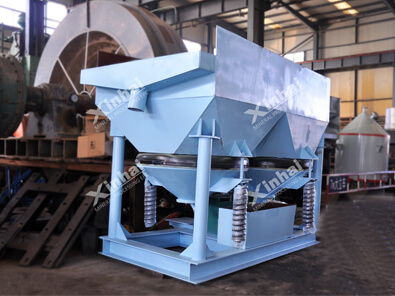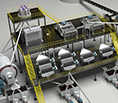Application of Gravity Separation in Five Gold Ores
 Laura
Laura
 Dec 31, 2021
Dec 31, 2021
 1650
1650
If you want to know more details about equipment, solutions, etc, please click the button below for free consultation, or leave your requirements!

Through the first two articles, we understand the application of the main equipment in gold ore separation and the two main process methods of gravity separation, namely single single gravity separation process and joint combined gravity separation process. In this paper, we will mainly introduce the application of gravity separation process in the beneficiation of five gold ores. Let's drive in!
01 Au-Bearing Quartz Vein Deposit
Back(1) Properties
Metal minerals in Au-bearing quartz vein deposit are mainly pyrite, chalcopyrite, natural gold, sphalerite, galena, silver gold, etc. Nonmetallic minerals are mainly quartz, sericite, etc. Natural gold is the most distributed in pyrite, followed by quartz ; pyrite is the most widely distributed silver-gold ore, followed by chalcopyrite. Natural gold and silver-gold ore occur in the ore as monomer or silver-embedded structure in three states of coarse grain, particle and sub-dominant particle, and coarse grain gold accounts for about 60 %. Natural gold and silver-gold ore are easy to be separated from other ores, and can be recycled by gravity separation due to the high content of coarse grain.
(2) Application
The gold ores in Au-bearing quartz vein deposit mostly adopt gravity separation process, which can collect more gold as soon as possible, directly produce alloy gold, accelerate capital turnover, reduce environmental pollution, reduce gold loss in flotation tailings, and improve the total gold recovery rate. In addition, in order to reduce the pollution of mercury to the environment, some concentrators changed the mixed mercury method to the reconcentration process.
02 Fragmented Altered Rock Gold Deposit
Back(1) Properties
The non-metallic minerals in the fractured altered rock gold deposits are mainly quartz, sericite and orthoclase. Metallic minerals account for about 3.2% of the total. Most of them are pyrite and galena. The average content of natural gold is 0.002 %, the distribution is extremely uneven in the ore, and its occurrence state can be divided into three categories:
a) Fissure gold: It exists in the crevices of other minerals and is easily separated from other minerals. The relative content of natural gold accounts for 91.7%.
b) Inclusion gold: It exists in the crystal gaps of other minerals and is not easy to separate from other minerals. The relative content is only 4.01%.
c) The relative content of natural gold associated with quartz accounts for 4.3%.
(2) Application
| Particle Size (mm) | Spikelets Per Panicle | Relative Amount (%) | Cumulative Content (%) |
| 0.3~0.1 | 2 | 16.9 | 16.9 |
| 0.1~0.074 | 5 | 17.4 | 34.3 |
| 0.074~0.053 | 14 | 22.3 | 56.6 |
| 0.053~0.037 | 28 | 22.9 | 79.5 |
| 0.037~0.01 | 118 | 19.3 | 98.8 |
| <0.01 | 58 | 12 | 100.0 |
(Grain size composition of natural gold in fractured altered rock gold deposits)
According to the above table, the relative content of natural gold larger than 0.037mm is 79.5%, accounting for 73.32 of the total metal content. If the gravity recovery of fine-grained gold is not considered, only the recovery of +0.037mm gold is considered, and the operating recovery rate is 50% Calculated, the amount of metal recovered by re-election is expected to reach more than 35% of the total recovery rate, which is fully confirmed by existing production. Most of the concentrators processing this type of ore increase the gravity separation in the grinding cycle to increase the total gold recovery rate and have a good effect.
03 Porphyry Copper-Gold Deposit
Back(1) Properties
The metal minerals in porphyry copper-gold deposits mainly include specularite and limonite, followed by a small amount of chalcopyrite and natural gold; gangue minerals include quartz, sericite, etc. The silver-gold ore is mainly in the form of wafers and granules. The particle size is generally 0.04~0.025mm, and individual is less than 0.005mm. It is embedded in the crystal gap of specularite and individually wrapped in chalcopyrite and pyrite.
(2) Application
Because most of the natural gold and silver-gold deposits in porphyry copper-gold deposits are filled in fissures and crystal crevices, they are easy to separate and recover from other minerals. For example, the results of amalgamation + shaking table test in a gold mine are:
The mercury recovery rate is 57.1%; the shaking table recovery rate is 29.03%; the concentrate grade is 73.75g/t; the total gold recovery rate is 83.73%.
Among them, most of the amalgamated gold is a monomer, and a few are rich conglomerates; the heavy-selected gold is mostly rich conglomerates, and a few are monomers. Most of the gold recovered by amalgamation can be recovered by gravity separation. The concentrator uses a single flotation process, and the recovery rate is only 74.4%. The reason for the low recovery rate is that the pharmaceutical system is relatively simple, and the process flow is not perfect. A gravity separation process can be added to the grinding system, not only to recover coarse gold, but also to recover a part of gold-containing oxide ore and monomer gold contaminated by oxides, which is beneficial to increase the gold recovery rate.
04 Skarn Copper-Gold Deposit
Back(1) Properties
Skarn copper-gold deposits mainly contain copper magnetite, copper skarn and magnetite. The main metallic minerals are magnetite, followed by pyrite and chalcopyrite, with a small amount of natural gold and bornite; non-metallic minerals mainly include diopside, garnet, epidote, etc. The grain size of gold is not uniform.
(2) Application
Grain size (mm) | Chalcopyrite | Pyrite | Magnetite | Hematite | Natural Gold |
| 0.3~0.1 | --- | 66.1 | 26.1 | 21.2 | --- |
| 0.1~0.074 | --- | 16.6 | 17.4 | 16.4 | 46 |
| 0.074~0.053 | --- | --- | 13.9 | 21.3 | 41.5 |
| 0.053~0.037 | 15.5 | --- | 20.8 | 14.2 | --- |
| 0.037~0.01 | 58.1 | 14.0 | 15.9 | 19.5 | 12.2 |
| ~0.01 | 26.4 | 3.3 | 2.9 | 7.4 | 0.3 |
| Total | 100 | 100 | 100 | 100 | 100 |
(Particle size table of the embedded gold and metallic minerals in skarn copper-gold deposits)
Two mines of this type used the amalgamation + flotation and amalgamation + magnetic separation processes to test the results respectively.
(a) The recovery rate of amalgamated gold is 72.18%
The gold recovery rate of copper concentrate is 16.68%, and the grade is 13g/t
The recovery rate of sulphur concentrate gold is 4.64%, and the grade is 3.5g/t
The recovery rate of magnetite gold is 6.46%, and the grade is 0.2g/t
(b) Amalgamated gold: gold recovery rate is 83.45~84.98%
Copper concentrate: gold recovery rate is 8.27~8.92%
The recovery rates of amalgamated gold in these two concentrators were 72.18% and 83.45~84.98%, that is, natural gold larger than 0.053mm (87.5%) in the original ore, most of which can be recovered by amalgamation.
05 Gold-Silver Deposit
Back(1) Properties
In primary gold and silver ore, silver is often in the form of spiral pyrite, deep red silver ore, brittle silver ore, sulphur antimony copper silver ore, light red silver ore and natural silver, and a small amount of silver telluride can also be seen. Among the oxidized ores, there are silver halides-mainly hornsilite, sulfate and natural silver.
(2) Application
In gold-silver deposits, silver minerals often coexist closely with clay minerals, iron oxide and manganese oxide, and natural silver particles are often covered by thin films of metal oxides and hydroxides. Some sulfides are also rich in fine silver particles, such as galena, chalcopyrite, pyrite and antimonite. Among them, the silver content of galena can reach 0.1%, sometimes 0.5~1%, and these fine silver particles cannot be dissociated during the grinding process.
Silver can be enriched by gravity separation, but its enrichment degree is lower than that of gold, and it is usually processed by a jig. Catch coarse (greater than 0.1~0.2mm) heavy minerals, such as natural silver, argentite and angle silver ore. These minerals are not only large in specific gravity, but also malleable. The rest of the silver minerals are very brittle and become very fine during the grinding process, making it difficult to recover using a jig. It can be seen that in order to increase the recovery rate of gold and silver during the gravity separation method, it is necessary to adopt stage grinding, and at the same time adopt other more effective methods to replace the jigging operation. The amalgamation method can only recover natural silver. Compared with gold, silver itself is not easy to be wetted by mercury, and the surface of silver particles is often covered with various films that hinder the amalgamation process. The amalgamation method is only suitable for the treatment of heavy concentration concentrates.
Many silver-containing gravity concentrates often need to be roasted before cyanidation.
Silver-gold ore is often sorted by a combined process composed of two and multiple methods. When there are coarse-grained (greater than 0.1~0.2mm) natural gold and natural silver in the ore, the re-selection process is often used.
06To Wrap Up
BackThe practice of gravity separation in gold separation plant shows that gravity separation process, as a supplement of other beneficiation methods, has remarkable effect on reducing tailing grade, improving gold recovery rate, increasing production and reducing cost. However, due to the difference of gold ore according to the properties of ore and other aspects, we need to combine the properties of different gold ores in the actual separation to select the appropriate beneficiation process and equipment.
 +86 183 3575 8886
+86 183 3575 8886 pinklaurabao@gmail.com
pinklaurabao@gmail.com




 Message
Message Chat Now
Chat Now




















